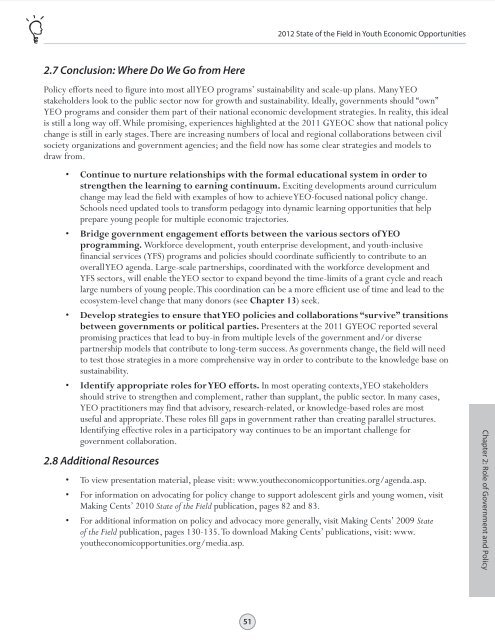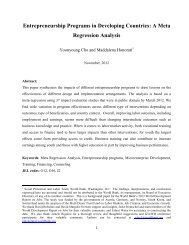STATE OF THE FIELD IN YOUTH ECONOMIC OPPORTUNITIES
STATE OF THE FIELD IN YOUTH ECONOMIC OPPORTUNITIES
STATE OF THE FIELD IN YOUTH ECONOMIC OPPORTUNITIES
Create successful ePaper yourself
Turn your PDF publications into a flip-book with our unique Google optimized e-Paper software.
Table of Contents<br />
Chapter 9<br />
Chapter 1 Chapter 2 Chapter 3 Chapter 4 Chapter 5 Chapter 6 Chapter 7 Chapter 8<br />
Chapter 10 Chapter 11 Chapter 12 Chapter 13 Chapter 14 Chapter 15 Annexes<br />
2012 State of the Field in Youth Economic Opportunities<br />
2.7 Conclusion: Where Do We Go from Here<br />
Policy efforts need to figure into most all YEO programs’ sustainability and scale-up plans. Many YEO<br />
stakeholders look to the public sector now for growth and sustainability. Ideally, governments should “own”<br />
YEO programs and consider them part of their national economic development strategies. In reality, this ideal<br />
is still a long way off. While promising, experiences highlighted at the 2011 GYEOC show that national policy<br />
change is still in early stages. There are increasing numbers of local and regional collaborations between civil<br />
society organizations and government agencies; and the field now has some clear strategies and models to<br />
draw from.<br />
• Continue to nurture relationships with the formal educational system in order to<br />
strengthen the learning to earning continuum. Exciting developments around curriculum<br />
change may lead the field with examples of how to achieve YEO-focused national policy change.<br />
Schools need updated tools to transform pedagogy into dynamic learning opportunities that help<br />
prepare young people for multiple economic trajectories.<br />
• Bridge government engagement efforts between the various sectors of YEO<br />
programming. Workforce development, youth enterprise development, and youth-inclusive<br />
financial services (YFS) programs and policies should coordinate sufficiently to contribute to an<br />
overall YEO agenda. Large-scale partnerships, coordinated with the workforce development and<br />
YFS sectors, will enable the YEO sector to expand beyond the time-limits of a grant cycle and reach<br />
large numbers of young people. This coordination can be a more efficient use of time and lead to the<br />
ecosystem-level change that many donors (see Chapter 13) seek.<br />
• Develop strategies to ensure that YEO policies and collaborations “survive” transitions<br />
between governments or political parties. Presenters at the 2011 GYEOC reported several<br />
promising practices that lead to buy-in from multiple levels of the government and/or diverse<br />
partnership models that contribute to long-term success. As governments change, the field will need<br />
to test those strategies in a more comprehensive way in order to contribute to the knowledge base on<br />
sustainability.<br />
• Identify appropriate roles for YEO efforts. In most operating contexts, YEO stakeholders<br />
should strive to strengthen and complement, rather than supplant, the public sector. In many cases,<br />
YEO practitioners may find that advisory, research-related, or knowledge-based roles are most<br />
useful and appropriate. These roles fill gaps in government rather than creating parallel structures.<br />
Identifying effective roles in a participatory way continues to be an important challenge for<br />
government collaboration.<br />
2.8 Additional Resources<br />
• To view presentation material, please visit: www.youtheconomicopportunities.org/agenda.asp.<br />
• For information on advocating for policy change to support adolescent girls and young women, visit<br />
Making Cents’ 2010 State of the Field publication, pages 82 and 83.<br />
• For additional information on policy and advocacy more generally, visit Making Cents’ 2009 State<br />
of the Field publication, pages 130-135. To download Making Cents’ publications, visit: www.<br />
youtheconomicopportunities.org/media.asp.<br />
Chapter 2: Role of Government and Policy<br />
51

















